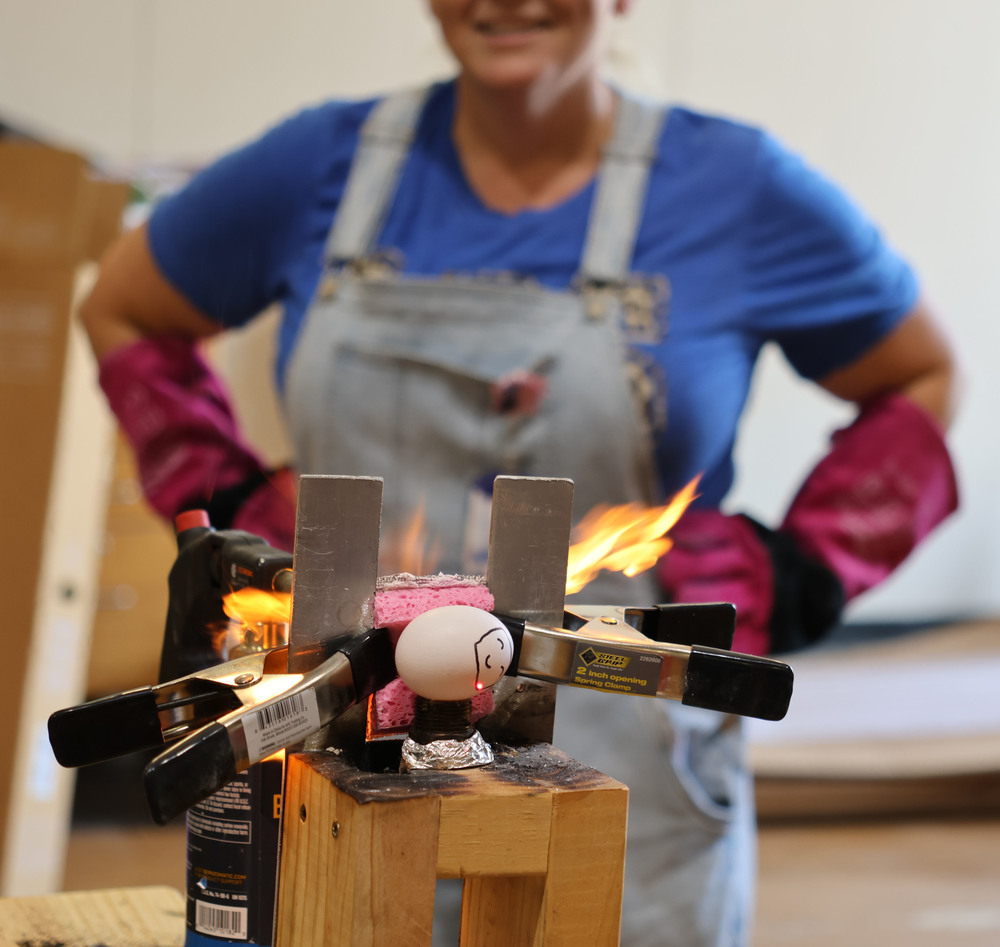Eggbert, against all odds, survived his re-entry journey into Earth’s atmosphere. No one, especially those designing his heat shield, expected him to come through unscrambled.
Eggbert was one of several “eggstronauts” who were subjected to the blow torch treatment recently during a training session for Lawton Public Schools’ Makerspace teachers, who were trying out a new activity for their elementary students.
The concept was simple: Teams of teachers were tasked with designing a heat shield to protect an egg from the flames of a blow torch, simulating astronauts’ re-entry into Earth’s atmosphere. Each team could “buy” materials with which to build their heat shield. Each material, such as foil, mesh, cotton balls or a sponge, cost a set amount of points. With a budget of just 100 points (even NASA has a budget), teams had to decide which items to buy. Another twist was thrown in: points not used to buy materials would go toward the final point total for each team; the team with the most points would win.
The survival of the eggstronaut also counted toward the point total. Teams received 200 points for no charring/no cooking of their eggstronaut, 100 points for some charring/cooking and zero points if the eggstronaut was charred/cooked; i.e. did not survive re-entry.
First the teams had to decide at what temperature their eggstronauts could survive for 3 minutes (the time it takes a space capsule to re-enter Earth’s atmosphere and splash down). The burning question was what temperature would kill a person (or fry an egg)?
First, 120 degrees was suggested. Then someone noted that it gets to 120 degrees in the desert and people survive. The group finally decided the eggstronauts, which were just chilling in the refrigerator, would “die” if their internal temperature reached 130 degrees or greater.
Teams then decided which materials they wanted to use. Their choices consisted of wire mesh, foil, cotton balls, felt, a sponge, lasagna noodles and spackle. One team decided not to use cotton balls because they were too expensive.
“We’re saving an egg’s life,” James Cunningham, Makerspace teacher at Sullivan Village Elementary School, said as his team debated which materials to use.
His team finally decided on felt, cotton balls, foil, cork and spackle for a grand total of $90. Team members decided not to use all of their money on materials and put some toward their point total.
Then, it was time for the moment of truth. A heat shield designed by a team of three men was put into place and their eggstronaut was positioned in front of it. The eggstronaunt’s temperature was taken and recorded, the blow torch was lit and the 3-minute countdown began.
Before too long the heat shield started smoking and the back of the egg began to turn black.
“It doesn’t smell great,” said Doris Biegler, LPS STEM coordinator.
At the end of 3 minutes, the heat gun had a reading of 297 degrees. Everyone agreed the first eggstronaut did not survive re-entry.
After seeing the fate of the first eggstronaut, Beth Perry, Makerspace teacher at Lawton Virtual Academy, gave a frank assessment of the chances of her team’s eggstronaut surviving.
“We’re going to lose,” she said.
Before long, it was Eggbert’s turn in the hot seat. His designers took their time in carefully placing the heat shield, created with a sponge, wire mesh and some spackle, just right. When he was placed in his seat a discussion ensued over how to position him. One of the heat shield designers wanted to face him toward the shield, declaring she didn’t want to see his hand-drawn face.
Fearing Eggbert was too tall for the heat shield to provide adequate protection, they decided to lay him on his side, with his little face turned away from the blow torch.
“Goodbye,” one team member said before the blow torch was lit.
“Sorry,” another chimed in.
The heat gun recorded his temperature as 91 degrees before the blow torch was lit and the countdown began. At 1 minute, 30 seconds, the temperature was recorded at 173 degrees. Eggbert’s final temperature was recorded at 203 degrees at the end of his re-entry period.
“He’s still smiling at us,” one of his team members said.
“He’s from Lawton, he’s used to the heat,” Biegler said.
A final check of his temperature was recorded at 98 degrees.
“I think he made it,” Perry said.
The group discovered that the heat gun was picking up the temperature of the flame from the blow torch instead of from the egg. They decided a more accurate reading was to take the temperature after the torch was turned off, hence the discrepancy in readings.
The final test came when Biegler took the eggstronauts outside and cracked them open. Even the yolk of the one that was charred on the outside was runny and not cooked.
Eggbert had a nice, firm yolk.
“This is really cool,” Tina Llopis, Makerspace teacher at Almor West, said of the activity. She said she plans to do the experiment in the spring during testing week.
“This is a nice brain break for them from thinking linearly,” she said.

